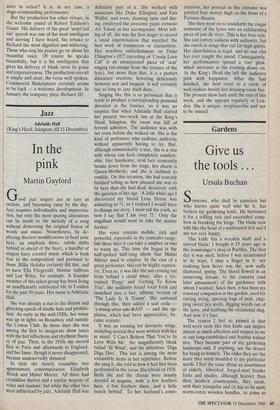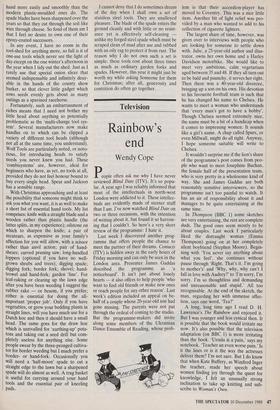Gardens
Give us the tools . . .
Ursula Buchan
S, omeone, who shall be nameless but who knows quite well who he is, has broken my gardening knife. He borrowed it for a trifling task and succeeded some- how in breaking the hinge. The blade now lolls like the head of a maltreated doll and I am not very happy.
This knife has a wooden shaft and a curved blade; I bought it 15 years ago in the ironmonger's shop in Peebles. The first day it was used, before I was accustomed to its ways, I shut a finger in it, not realising how fierce was the, now sadly shattered, spring. The blood flowed in an unnerving stream, to the concern (and later amusement) of the gardeners with whom I worked. Since then, it has been my constant companion in the garden, used for cutting string, opening bags of peat, chip- ping sweet pea seeds, digging weeds out of the lawn, and stabbing the occasional slug. And now it's bust.
The reason I feel so pained is that well-worn tools like that knife can inspire almost as much affection and respect in me as our long-established and fruitful walnut tree. They become part of my gardening landscape and, if anything, are the dearer for being so homely. The older they are the more they seem moulded to my particular needs. I feel the same about an assortment of elderly, inherited, forged-steel border forks and spades; although heavier than their modern counterparts, they seem, with their triangular and (it has to be said) worm-eaten wooden handles, to come to hand more easily and smoothly than the modern plastic-moulded ones do. The spade blades have been sharpened over the years so that they cut through the soil like wire through cheese. So fond of them am I that I feel no desire to own one of their epoxy-coated successors.
In any event, I have no room in the tool-shed for anything more, so full is it of one-use tools which never see the light of day except on the one winter's afternoon in the year when I tidy out the shed. Just as I rarely use that special onion slicer that seemed indispensable and infinitely desir- able in the hands of the county show barker, so that clever little gadget which sows seeds evenly gets about as many outings as a spavined racehorse.
Fortunately, such an embarrassment of riches means that I need not bother my little head about anything so potentially problematic as the 'multi-change tool sys- tem'. Several manufacturers now make handles on to which can be clipped a variety of different tool heads (although not all at the same time, you understand). Wolf Tools are particularly noted, or noto- rious, for introducing heads to satisfy needs you never knew you had. These `combisystems' are, however, ideal for beginners who have, as yet, no tools at all, provided they do not feel honour bound to buy every single head. Spear and Jackson has a sensible range.
With Christmas approaching and at least the possibility that someone might think to ask you what you want, it is as well to make a short list of essential hand tools. My list comprises: knife with a straight blade and a wooden rather than plastic handle (the latter splits, in my experience); oilstone on which to sharpen the knife; a pair of secateurs, as expensive as your family's affection for you will allow, with a scissor rather than anvil action; pair of hand- shears; curved pruning saw; long-handled loppers (optional if you have no well- grown shrubs and trees); digging spade; digging fork; border fork; shovel; hand- trowel and hand-fork; garden 'line'. For leaf-raking or clearing up the lawn edge after you have been weeding I suggest the rubber rake — or besom, if you prefer; either is essential for doing the all- important 'proper job'. Only if you have vegetables, or grow your bedding plants in straight lines, will you have much use for a Dutch hoe and then it should have a small head. The same goes for the draw hoe which is unrivalled for 'earthing-up' pota- toes and taking out a seed drill but com- pletely useless for anything else. Some people swear by the three-pronged cultiva- tor for border weeding but I much prefer a border- or hand-fork. Occasionally you will need a 'half-moon' spade to cut a straight edge to the lawn but a sharpened spade will do almost as well. A trug basket is useful for carrying around your hand tools and the essential pair of kneeling pads. I cannot deny that I do sometimes dream of the day when I shall own a set of stainless steel tools. They are unalloyed pleasure. The blade of the spade enters the ground cleanly and with little or no resist- ance yet is effectively self-cleaning — unlike my forged steel spade which must be scraped clean of mud after use and rubbed with an oily rag to protect it from rust. The reason why I do not own such a set is simple: these tools cost about three times as much as ordinary garden forks and spades. However, this year it might just be worth my while asking Someone for them for Christmas; after all, generosity and contrition do often go together.



























































 Previous page
Previous page